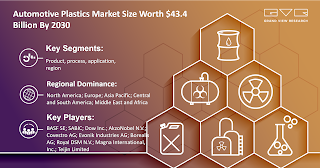Automotive Plastics Market is Predicted to Observe a Tremendous Growth, With a CAGR of 4.7% From 2022 To 2030: Grand View Research Inc.
The global automotive
plastics market size is expected
to reach USD 43.4 billion by 2030,
according to a new report by Grand View Research, Inc. The market is expected
to expand at a CAGR of 4.7% from 2022 to
2030. A rising preference for high-performance plastics to substitute
conventional metals and rubber is expected to impel the market growth.
The COVID-19 pandemic negatively
impacted automotive plastics manufacturers by halting automotive production and
reducing vehicle demand due to global financial instability. The outbreak
disturbed the entire automotive supply chain on a worldwide scale. Since the
market for automobiles is entirely dependent on vehicle sales, this outbreak
affected this market significantly. However, the market grew substantially in
2021 primarily due to the increased electric vehicle sales and is therefore
expected to stimulate the market growth over the forecast period.
The polyurethane product segment is
anticipated to witness significant growth over the forecast period owing to its
ability to infuse the characteristics of both plastics and rubber at a lower
weight compared to metal and other plastic materials. Increasing product demand
from the automotive industry for use in refrigeration insulation, interior
trims, and seat cushioning is expected to boost product demand over the
forecast period. In September 2021, Adient, a pioneer in automotive seating
systems, and Covestor confirmed a strategic alliance. The company will
integrate cardyon, a polyol made utilizing Covestro's CO2 technology as a
self-sustaining material in the manufacturing of hot cure-shaped polyurethane
foam utilized as cushioning in automotive seating systems.
The power train application segment is
expected to witness the fastest growth over the forecast period. The rising
application of plastics in powertrain engineering is expected to support market
growth in the coming years. It helps the manufacturers of vehicles reduce
weight and integrate complex parts, which ultimately boosts performance,
delivers higher productivity, and saves cost. According to research conducted
by E. I. du Pont de Nemours and Company, currently, plastics penetration stands
at 110-120 kilograms per car depending on the engine size and region, while
manufacturers are still exploring other new opportunities for the usage of
plastics.
To Request Sample Copy of this report, click the link:
https://www.grandviewresearch.com/industry-analysis/automotive-plastics-market/request/rs1
Globally, recovery in the automotive
sector, improved vehicle design capabilities, and increasing focus on vehicle
weight reduction and emission control are the key factors boosting the growth
of the market for automotive plastics. Plastics are widely used in automotive
components and parts owing to easy manufacturing, possible sourcing from
renewable raw materials, and improved designs.
Automotive Plastics Market Report Highlights
- Increasing
integration of in-car entertainment and communication systems, engine
electronics, advanced safety, and advanced driver-assistance systems is
boosting the demand for electrical components application, which, in turn,
is fueling the growth of the market in North America
- The
polypropylene product segment accounted for the largest revenue share of
more than 30.0% in 2021 and is estimated to maintain its lead over the
forecast period
- The
interior furnishings application segment is expected to be the largest
segment over the forecast period owing to the rising product usage for
interior furnishings in automobiles including body and light panels, seat
covers, steering wheels, and fascia systems
- Various
strategic initiatives were recorded over the past few years in order to
boost the growth of the market. For instance, in May 2022, Covestro AG
announced its plan to expand the production capacity of polycarbonate
films at its Dormagen site in Germany. The site, which is expected to come
on stream by the end of 2020, will manufacture PC films for applications
such as automotive interiors, security cards, medical devices, and
automotive displays
The COVID-19 pandemic impacted the
market due to a drop in new vehicle sales, the shutdown of production facilities,
a limited supply of vehicle parts, and a decline in working capital. It led to
the interruption in the supply chain and suspension of production, resulting in
reduced retail sales. Furthermore, many individuals were uncertain about their
jobs and the long-term economic and health effects of the virus on their lives,
influencing their purchasing decisions.
Polypropylene (PP), Polyvinyl Chloride
(PVC), Acrylonitrile Butadiene Styrene (ABS), and Polyurethane (PU) are the
most commonly utilized materials for vehicle parts and component applications.
Plastics undergo five different stages while recycling including sorting,
washing, shredding, identification, and classification, and extruding into the
final component or product. Improvements in recycling processes have forced
manufacturers to use high-performance automotive plastics. Usually, an average
car consists of 5.8 to 10% of plastics, depending on fuel-efficiency standards
and performance requirements, with consumption in vehicular equipment
accounting for over 110-120 kg in an average car.
List of Key Players of Automotive Plastics Market
- BASF SE
- SABIC
- Dow Inc.
- AkzoNobel
N.V.
- Covestro
AG
- Evonik
Industries AG
- Borealis
AG
- Royal DSM
N.V.
- Magna
International, Inc.
- Teijin
Limited




Comments
Post a Comment